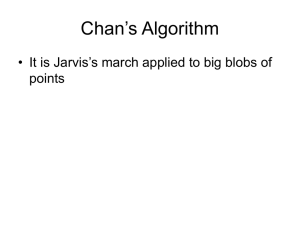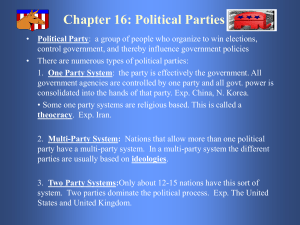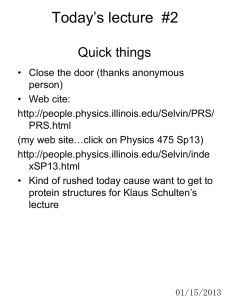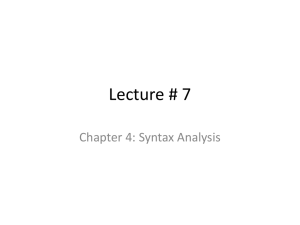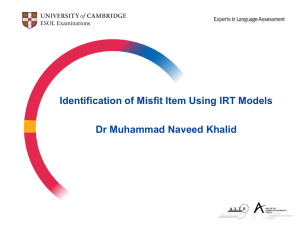PPT
advertisement
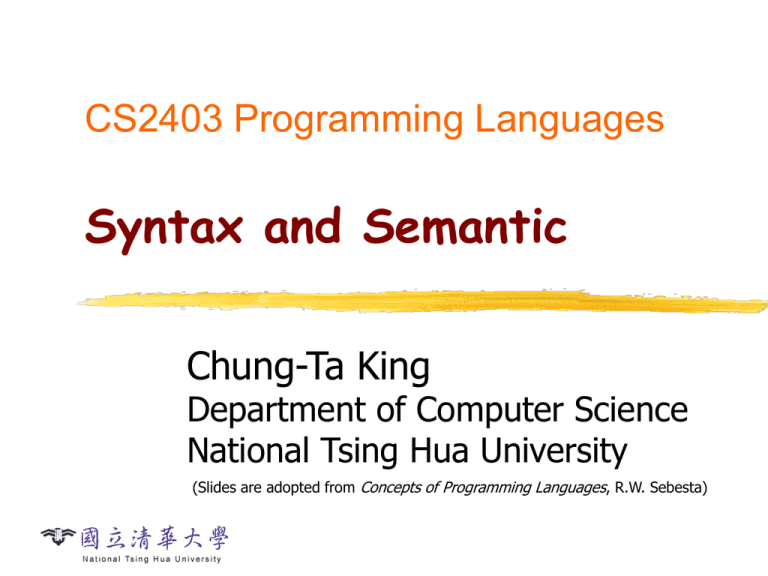
CS2403 Programming Languages
Syntax and Semantic
Chung-Ta King
Department of Computer Science
National Tsing Hua University
(Slides are adopted from Concepts of Programming Languages, R.W. Sebesta)
Roadmap
Ch. 1
Ch. 2
Classification of languages
What make a “good” language?
Evolution of languages
Ch. 3
How to define languages?
Ch. 4
Ch. 5
How to compile and translate programs?
Variables in languages
Ch. 7
Statements and program constructs in languages
Ch. 15
Functional and logic languages
1
Outline
Introduction (Sec. 3.1)
The General Problem of Describing Syntax (Sec.
3.2)
Formal Methods of Describing Syntax (Sec. 3.3)
Attribute Grammars (Sec. 3.4)
Describing the Meanings of Programs:
Dynamic Semantics (Sec. 3.5)
2
How to Say It Right?
Suppose you mean to say
國立清華大學位於新竹市。
What is wrong with this “sentence”?
National Tsing Hua University in Hsinchu.
Can it convey the meaning?
Wrong grammar often obscure the meanings
What about these “sentences”?
National Tsing Hua University walks in Hsinchu.
Hsinchu is in National Tsing Hua University.
3
Description of a Language
Syntax: the form or structure of the
expressions, statements, and program units
Semantics: the meaning of the expressions,
statements, and program units
What programs do, their behavior and meaning
So, when we say one’s English grammar is
wrong, we actually mean _______ error?
4
What Kind of Errors They Have?
National Tsing Hua University in Hsinchu.
National Tsing Hua University am in Hsinchu.
National Tsing Hua University walks in Hsinchu.
Hsinchu is in National Tsing Hua University.
5
Describing Syntax and Semantics
Syntax is defined using some kind of rules
Specifying how statements, declarations, and other
language constructs are written
Semantics is more complex and involved. It is
harder to define, e.g., natural language doc.
Example: if statement
Syntax: if (<expr>) <statement>
Semantics: if <expr> is true, execute
<statement>
Detecting syntax error is easier, semantics error
is much harder
6
Outline
Introduction (Sec. 3.1)
The General Problem of Describing Syntax (Sec.
3.2)
Formal Methods of Describing Syntax (Sec. 3.3)
Attribute Grammars (Sec. 3.4)
Describing the Meanings of Programs:
Dynamic Semantics (Sec. 3.5)
7
What is a Language?
In programming language terminologies, a
language is a set of sentences
A sentence is a string of characters over some
alphabet
The meaning of a “sentence” is very general. In
English, it may be an English sentence, a paragraph,
or all the text in a book, or hundreds of books, …
Every C program, if can be compiled properly, is
a sentence of the C language
No matter whether it is “hello world” or a program
with several million lines of code
8
A Sentence in C Language
The “Hello World” program is a sentence in C
main()
{ printf("hello, world!\n"); }
What about its alphabet?
For illustration purpose, let us define the alphabet as
a identifier
b string
c’(‘
d’)’
e’{‘
f’}’
g’;’
So, symbolically “Hello World” program can be
represented by the sentence: acdeacbdgf
where “main” and “printf” are identifiers and “hello,
world!\n” is a string
9
Sentence and Language
So, we say that acdeacbdgf is a sentence of (or,
in) the C language, because it represents a legal
program in C
Note: “legal” means syntactically correct
How about the sentence acdeacbdf?
It represents the following program:
main()
{ printf("hello, world!\n") }
Compiler will say there is a syntax error
In essence, it says the sentence acdeacbdf is not in C
language
10
So, What a C Compiler Does?
Frontend: check whether the program is “a
sentence of the C language”
Lexical analysis: translate C code into corresponding
“sentence” (intermediate representation, IR) Ch. 4
Syntax analysis: check whether the sentence is a
sentence in C Ch. 4
Not much about what it means semantics
Backend: translate from “sentence” (IR) into
object code
Local and global optimization
Code generation: register and storage allocation, …
11
Definition of a Language
The syntax of a language can be defined by a
set of syntax rules
The syntax rules of a language specify which
sentences are in the language, i.e., which
sentences are legal sentences of the language
So when we say
你的句子不合英文文法。
we actually say
你的句子不在英文裡。
12
Syntax Rules
Consider a special language X containing
sentences such as
NTHU is in Hsinchu.
NTHU belongs to Hsinchu.
A general rule of the sentences in X may be
A sentence consists of a noun followed by a verb,
followed by a preposition, and followed by a noun,
where a noun is a place
a verb can be “is” or “belongs” and
a preposition can be “in” or “to”
13
Syntax Rules
A more concise representation:
A hierarchical
structure of
language
<sentence> <noun> <verb> <preposition> <noun>
<noun> place
<verb> “is” | “belongs” <preposition> “in” | “to”
With these rules, we can generate followings:
NTHU is in Hsinchu
Hsinchu is in NTHU
Hsinchu belongs to NTHU
They are all in language X
Its alphabet includes “is”, “belongs”, “in”, “to”, place
14
Checking Syntax of a Sentence
How to check if the following sentence is in the
language X?
NTHU belongs in Hsinchu
Idea: check if you can generate that sentence
This is called parsing
How?
Try to match the input sentence with the
structure of the language
15
Matching the Language Structure
<sentence>
<noun> <verb> <preposition> <noun>
So, the sentence is in the language X!
NTHU
belongs in
Hsinchu
The above structure is called a parse tree
16
Summary: Language, Sentence
Language
Chinese
C
Syntax
rules
English
Sentence
How are you?
NTHU is in Hsinchu.
Alphabet
a,b,c,d,…
17
Outline
Introduction (Sec. 3.1)
The General Problem of Describing Syntax (Sec.
3.2)
Formal Methods of Describing Syntax (Sec. 3.3)
Issues in Grammar Definitions: Ambiguity,
Precedence, Associativity, …
Attribute Grammars (Sec. 3.4)
Describing the Meanings of Programs:
Dynamic Semantics (Sec. 3.5)
18
Formal Description of Syntax
Most widely known methods for describing syntax:
Context-Free Grammars
Developed by Noam Chomsky in the mid-1950s
Define a class of languages: context-free languages
Backus-Naur Form (1959)
Invented by John Backus to describe ALGOL 58
Equivalent to context-free grammars
19
BNF Terminologies
A lexeme is the lowest level syntactic unit of a
language (e.g., NTHU, Hsinchu, is, in)
A token is a category of lexemes (e.g., place)
A BNF grammar consists of four parts:
The set of tokens and lexemes (terminals)
The set of non-terminals, e.g., <sentence>, <verb>
The start symbol, e.g., <sentence>
The set of production rules, e.g.,
<sentence> <noun> <verb> <preposition> <noun>
<noun> place
<verb> “is” | “belongs” <preposition> “in” | “to”
20
BNF Terminologies
Tokens and lexemes are smallest units of syntax
Lexemes appear literally in program text
Non-terminals stand for larger pieces of syntax
Do NOT occur literally in program text
The grammar says how they can be expanded into
strings of tokens or lexemes
The start symbol is the particular non-terminal
that forms the starting point of generating a
sentence of the language
21
BNF Rules
A rule has a left-hand side (LHS) and a righthand side (RHS)
LHS is a single non-terminal context-free
RHS contains one or more terminals or non-terminals
A rule tells how LHS can be replaced by RHS, or how
RHS is grouped together to form a larger syntactic
unit (LHS) traversing the parse tree up and down
A nonterminal can have more than one RHS
A syntactic list can be described using recursion
<ident_list> ident |
ident, <ident_list>
22
An Example Grammar
<program> <stmts>
<stmts> <stmt> | <stmt> ; <stmts>
<stmt> <var> = <expr>
<var> a | b | c | d
<expr> <term> + <term> | <term> - <term>
<term> <var> | const
<program> is the start symbol
a, b, c, const,+,-,;,= are the terminals
23
Derivation
A derivation is a repeated application of rules,
starting with the start symbol and ending with a
sentence (all terminal symbols), e.g.,
<program> => <stmts>
=> <stmt>
=> <var> = <expr>
=> a = <expr>
=> a = <term> + <term>
=> a = <var> + <term>
=> a = b + <term>
=> a = b + const
24
Derivation
Every string of symbols in the derivation is a
sentential form
A sentence is a sentential form that has only
terminal symbols
A leftmost derivation is one in which the
leftmost nonterminal in each sentential form is
the one that is expanded
A derivation may be neither leftmost nor
rightmost
25
Parse Tree
A hierarchical representation of a derivation
<program>
<stmts>
<stmt>
<var>
=
<expr>
a
<term>
+
<term>
<var>
const
b
a = b + const
26
Grammar and Parse Tree
The grammar can be viewed as a set of rules
that say how to build a parse tree
You put <S> at the root of the tree
Add children to every non-terminal, following
any one of the rules for that non-terminal
Done when all the leaves are tokens
Read off leaves from left to right—that is the
string derived by the tree
e.g., in the case of C language, the leaves form the C
program, despite it has millions of lines of code
27
How to Check a Sentence?
What we have discussed so far are how to
generate/derive a sentence
For compiler, we want the opposite
check whether the input program (or its
corresponding sentence) is in the language!
How to do?
Use tokens in the input sentence one by one to guide
which rules to use in derivation or to guide a reverse
derivation
28
Compiler Note
Compiler tries to build a parse tree for every
program you want to compile, using the
grammar of the programming language
Given a CFG, a recognizer for the language
generated by the grammar can be
algorithmically constructed, e.g., yacc
The compiler course discusses algorithms for doing
this efficiently
29
Outline
Introduction (Sec. 3.1)
The General Problem of Describing Syntax (Sec.
3.2)
Formal Methods of Describing Syntax (Sec. 3.3)
Issues in Grammar Definitions: Ambiguity,
Precedence, Associativity, …
Attribute Grammars (Sec. 3.4)
Describing the Meanings of Programs:
Dynamic Semantics (Sec. 3.5)
30
Three “Equivalent” Grammars
G1:
<subexp> a | b | c | <subexp> - <subexp>
G2:
<subexp> <var> - <subexp> | <var>
<var> a | b | c
G3:
<subexp> <subexp> - <var> | <var>
<var> a | b | c
These grammars all define the same language: the
language of strings that contain one or more as, bs
or cs separated by minus signs, e.g., a-b-c. But...
31
<subexp>
G2 parse tree:
<var>
-
<subexp>
a
<var>
-
<subexp>
b
<var>
What are
the
differences?
c
<subexp>
<subexp>
G3 parse tree:
<subexp>
<var>
a
-
-
<var>
<var>
c
b
32
Ambiguity in Grammars
If a sentential form can be generated by two or
more distinct parse trees, the grammar is said
to be ambiguous, because it has two or more
different meanings
Problem with ambiguity:
Consider the following grammar and the sentence
a+b*c
<exp> <exp> + <exp> | <exp> * <exp>
| (<exp>)| a | b | c
33
An Ambiguous Grammar
Two different parse trees for a+b*c
<exp>
<exp>
<exp>
a
+
*
<exp>
b
Means (a+b)*c
<exp>
<exp>
<exp>
c
a
+
<exp>
<exp>
*
b
<exp>
c
Means a+(b*c)
34
Consequences
The compiler will generate different codes,
depending on which parse tree it builds
According to convention, we would like to use the
parse tree at the right, i.e., performing a+(b*c)
Cause of the problem:
Grammar lacks semantic of operator precedence
Applies when the order of evaluation is not
completely decided by parentheses
Each operator has a precedence level, and those with
higher precedence are performed before those with
lower precedence, as if parenthesized
35
Putting Semantics into Grammar
<exp> <exp> + <exp> | <exp> * <exp>
| (<exp>) | a | b | c
To fix the precedence problem, we modify the
grammar so that it is forced to put * below + in
the parse tree
<exp> <exp> + <exp> | <mulexp>
<mulexp> <mulexp> * <mulexp>
| (<exp>)| a | b | c
Note the hierarchical structure
of the production rules
36
Correct Precedence
<exp>
<exp>
G5 parse tree:
+
<mulexp>
a
<exp>
<mulexp>
<mulexp> * <mulexp>
b
c
Our new grammar generates same language as before, but
no longer generates parse trees with incorrect precedence.
37
Semantics of Associativity
Grammar can also handle the semantics of
operator associativity
<exp> <exp> + <exp> | <mulexp>
<mulexp> <mulexp> * <mulexp>
| (<exp>)| a | b | c
<exp>
<exp>
+
<exp>
<exp>
<exp>
+
<mulexp>
<exp>
a
<mulexp>
<mulexp>
<mulexp>
<mulexp>
b
c
a
b
+
<exp>
<exp>
+
<exp>
<exp>
<mulexp>
c
38
Operator Associativity
Applies when the order of evaluation is not
decided by parentheses or by precedence
Left-associative operators group operands left to
right: a+b+c+d = ((a+b)+c)+d
Right-associative operators group operands right
to left: a+b+c+d = a+(b+(c+d))
Most operators in most languages are leftassociative, but there are exceptions, e.g., C
a<<b<<c — most operators are left-associative
a=b=0
— right-associative (assignment)
39
Associativity Matters
Addition is associative in mathematics?
(A + B) + C = A + (B + C)
Addition is associative in computers?
Subtraction and divisions are associative in
mathematics?
Subtraction and divisions are associative in
computers?
40
Associativity in the Grammar
<exp> <exp> + <exp> | <mulexp>
<mulexp> <mulexp> * <mulexp>
| (<exp>)| a | b | c
To fix the associativity problem, we modify the
grammar to make trees of +s grow down to the
left (and likewise for *s)
<exp> <exp> + <mulexp> | <mulexp>
<mulexp> <mulexp> * <rootexp> | <rootexp>
<rootexp> (<exp>)| a | b | c
41
Correct Associativity
<exp>
<exp>
<exp>
<mulexp>
<rootexp>
+
+
<mulexp>
<rootexp>
<mulexp>
<rootexp>
c
b
a
42
Dangling Else in Grammars
<stmt> <if-stmt> | s1 | s2
<if-stmt> if <expr> then <stmt> else <stmt>
| if <expr> then <stmt>
<expr> e1 | e2
This grammar has a classic “dangling-else
ambiguity.” Consider the statement
if e1 then if e2 then s1 else s2
43
Different
Parse Trees
<if-stmt>
if
<exp>
then
e1
if
<exp>
<stmt>
else
s2
<if-stmt>
then
<stmt>
<stmt>
e2
s1
<if-stmt>
Most languages that have if
this problem choose this
parse tree: else goes with
nearest unmatched then
if
<exp>
then
e1
<exp>
e2
then
<stmt>
<if-stmt>
<stmt>
s1
else
<stmt>
s2
44
Eliminating the Ambiguity
<stmt> <if-stmt> | s1 | s2
<if-stmt> if <expr> then <stmt> else <stmt>
| if <expr> then <stmt>
<expr> e1 | e2
If this expands into an if, that if must already have its own else.
First, we make a new non-terminal <full-stmt> that generates
everything <stmt> generates, except that it can not generate
if statements with no else:
<full-stmt> <full-if> | s1 | s2
<full-if> if <expr> then <full-stmt> else
<full-stmt>
45
Eliminating the Ambiguity
<stmt> <if-stmt> | s1 | s2
<if-stmt> if <expr> then <full-stmt> else <stmt>
| if <expr> then <stmt>
<expr> e1 | e2
Then we use the new non-terminal here.
The effect is that the new grammar can match an else part
with an if part only if all the nearer if parts are already
matched.
46
Languages That Don’t Dangle
Some languages define if-then-else in a way
that forces the programmer to be more clear
ALGOL does not allow the then part to be
another if statement, though it can be a block
containing an if statement
Ada requires each if statement to be
terminated with an end if
47
Extended BNF
Optional parts are placed in brackets [ ]
<proc_call> ident [(<expr_list>)]
Alternative parts of RHSs are placed inside
parentheses and separated via vertical bars
<term> <term> (+|-) const
Repetitions (0 or more) are placed inside braces
{}
<ident> letter {letter|digit}
48
BNF and EBNF
BNF
EBNF
<expr> <expr> + <term>
| <expr> - <term>
| <term>
<term> <term> * <factor>
| <term> / <factor>
| <factor>
<expr> <term> {(+ | -) <term>}
<term> <factor> {(* | /) <factor>}
49

